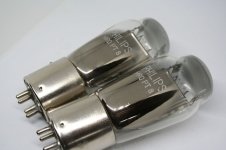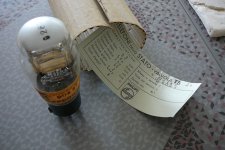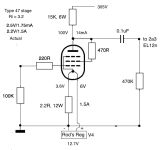Interested in seeing who is using any of these three tubes for a line stage, preamp or driver stage. Ale Moglia is a fan of both 46 and 47, see here...
https://www.bartola.co.uk/valves/?s=46
https://www.bartola.co.uk/valves/2020/07/25/300b-se-amp-47-driver/
I have also used 46 and 47, but not 49. The 46 is better sounding to me, but has a mu of 5.6 whereas 47 is 8. Same filament supply. Ale has used filament bias on these tubes despite the big heatsink and cathode resistors required, but gave up on it. I'm persevering with filament bias - it's always my choice where possible.
Here's a driver stage for my 2a3 outputs, with a 1:4 SUT for added gain. I also use a 10Y driver stage for the 2a3 but they're getting very expensive so I need an alternative as a daily driver. Big heatsink required for Rod's regs, and something like 100W metal clad cathode resistors.
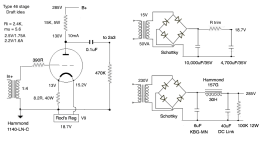
https://www.bartola.co.uk/valves/?s=46
https://www.bartola.co.uk/valves/2020/07/25/300b-se-amp-47-driver/
I have also used 46 and 47, but not 49. The 46 is better sounding to me, but has a mu of 5.6 whereas 47 is 8. Same filament supply. Ale has used filament bias on these tubes despite the big heatsink and cathode resistors required, but gave up on it. I'm persevering with filament bias - it's always my choice where possible.
Here's a driver stage for my 2a3 outputs, with a 1:4 SUT for added gain. I also use a 10Y driver stage for the 2a3 but they're getting very expensive so I need an alternative as a daily driver. Big heatsink required for Rod's regs, and something like 100W metal clad cathode resistors.

I tried the 47 (in triode) as an input tube in my direct coupled project. It sounded OK but it was a bit more microphonic than other types so I didn't spend a lot of time with it. This was before I picked up the Hammond SUTs based on your suggestion. Perhaps it would have been better as a driver with the SUT in front. Later, I tried the 49 as driver using the SUTs on the input.Interested in seeing who is using any of these three tubes for a line stage, preamp or driver stage.
The 49 was one of two tubes that were in the running for the build. The other was the 12A. I really could have been happy with either tube but in the end I went with the 12A. In this circuit the 12A had a fuller, richer, more palpable sound. The 49 was more detailed and a bit leaner, so I suspect you might prefer it.
I listened to the two on the breadboard for a couple of months. Deciding between them was a really tough call. To the point that I was considering building the amp with both 4 pin (12A) and 5 pin (49) sockets but I decided to choose one rather than complicate the build, which is in progress at this time.
One thing I learned from this is just how real synergy is. In my previous amp build I had tried the 12A (and many others) but I used the 26. In that circuit, the 12A sounded good but didn't bring anything special to the table. In this circuit, the 26 didn't sound particularly good at all and the 12A (and the 49) stood out.
I have a few 46s but I didn't want to deal with their higher filament current for this build so I haven't tried them in anything yet.
Very interesting, thanks! I don't have any 49s because the mu is only 4.7 and I need more gain. Ideally a mu of 8 like the 47 but 5.6 for the 46 will just about do. I use a 1:4 SUT on the input when using 2a3 (6C4C) outputs. Not needed with EL12n outputs.
Like you, I've played around endlessly with tubes like 2P29L, 4P1L, 26, 112A, 10Y, 46 and 47. All in filament bias to avoid cathode bypasses. 2P29L is the easiest to set up and a good entry into DHTs. 4P1L if you can put 30mA through it. Then 112A is pretty easy and like you say, a fuller sound. The 26 can be nice or can sound too warm, so a question of synergy as you say. We're already at 1A filaments here, so heatsinks required and the cathode resistor mounted above the top plate. Then on to yet bigger heatsinks for the 46, 47 and 10Y but to my ears these are the best of the bunch. The 10Y the most subtle and micro-detailed, the 46 more dynamic. The 47 a not-quite-so-good 46 but more gain and cheaper.
If you want an indirectly heated substitute with a mu of 8, then the 6AH4 is excellent and very cheap. I used it in a EL12n push-pull amp and was surprised at how nice that combination sounded.
Like you, I've played around endlessly with tubes like 2P29L, 4P1L, 26, 112A, 10Y, 46 and 47. All in filament bias to avoid cathode bypasses. 2P29L is the easiest to set up and a good entry into DHTs. 4P1L if you can put 30mA through it. Then 112A is pretty easy and like you say, a fuller sound. The 26 can be nice or can sound too warm, so a question of synergy as you say. We're already at 1A filaments here, so heatsinks required and the cathode resistor mounted above the top plate. Then on to yet bigger heatsinks for the 46, 47 and 10Y but to my ears these are the best of the bunch. The 10Y the most subtle and micro-detailed, the 46 more dynamic. The 47 a not-quite-so-good 46 but more gain and cheaper.
If you want an indirectly heated substitute with a mu of 8, then the 6AH4 is excellent and very cheap. I used it in a EL12n push-pull amp and was surprised at how nice that combination sounded.
Yeah, I've tried the 6AH4 and it was impressive. Another indirectly heated tube with a mu of 8.3 that I liked even more was the 6V7G. I didn't try it for this project because I wanted to use all DH tubes. But when I built the preamp that you inspired a few years ago (the Boogie Factor 1626) the 6V7G was one of my top 3, along with the 2P29L. It has a top cap but it connects to the grid not the plate. It also has two diodes but those can just be grounded.I don't have any 49s because the mu is only 4.7 and I need more gain. Ideally a mu of 8
The 6V7G is the octal version. The 85 is the same tube with a 6 pin base and the 55, which also uses a 6 pin base, is the same except it runs the heater on 2.5v at 1A.
I'm using battery grid bias on all these DHTs, which also eliminates the bypass cap issue and doesn't generate any heat. I'm heating the filaments with a Meanwell SMPS.
Last edited:
I'm building a simple version of the 46 in filament bias, without the 1:4 SUT. Not needed for my SE EL12n outputs which have a mu of 18 in triode. They're sounding very nice with a 6J5 input (CV1135) so should sound even better with a 46 in front. I'm using up some of Rod Coleman's older regs. For the V9 the supply voltage would be 9.5V.
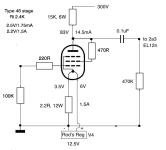

I've been using my EL12n in triode output stage for a while now - the 2a3 stages are on the shelf. I just did shootout between the three best driver stages I have - 26, 47 and 10Y. The 26 was very nice - more than I expected. In the ST version it wasn't warm sounding, it was very smooth and clean with excellent vocals and a nice bell-like sonority to the grand piano. The 47 was neutral with just a tinge of brightness, very clean again. The 10Y was neutral, dynamic and had more micro detail.
I'd say all three were very close - I could be happy with any of them. All three were a level up from 4P1L, 2P29L and 112A. All these were used in filament bias with Rod Coleman regs. I also found the cathode resistors, which are large with filament bias, made an audible contribution to the sound. I've been using Russian ceramic resistors but got better tonality with some stackable NOS wirewounds and some big porcelain ones. The aluminium clad resistors were not so good.
Sample schematics attached. I'm still using up my stock of V4 filament regs, but you would now use the V9 ones. When driving the EL12n the output would be 0.1uF teflon FT-2 and a 470K grid resistor.
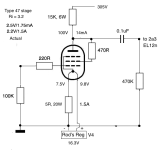
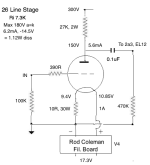
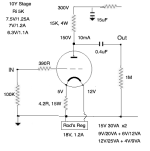
I'd say all three were very close - I could be happy with any of them. All three were a level up from 4P1L, 2P29L and 112A. All these were used in filament bias with Rod Coleman regs. I also found the cathode resistors, which are large with filament bias, made an audible contribution to the sound. I've been using Russian ceramic resistors but got better tonality with some stackable NOS wirewounds and some big porcelain ones. The aluminium clad resistors were not so good.
Sample schematics attached. I'm still using up my stock of V4 filament regs, but you would now use the V9 ones. When driving the EL12n the output would be 0.1uF teflon FT-2 and a 470K grid resistor.



Hi Andy; I have had very good experience following your taste in tubes, so first a big thank you for sharing here over the years.I have a SE amp with EL12n outputs, mu of 18 in triode so just needs an input tube with a mu of 8 or so. I had hopes for the 46, but turns out that the best fit with the EL12n is the 47, and it's really nice. Not what I expected but I'm happy.
Since I've got decent experience with the type 47; I found that in triode mode it sounds much better when being driven itself; aka 26 drives 47 (LL1660 4.5:4). Else the 47 sounds kind of flat and won't come away from the speakers convincingly. When driven, the 47 almost disappears - nearly neutral to a fault I feel compared to the 26.
I've got a 46 coming next week to trial a 26 > 42/46/47 > 50 combination, so I'm curious if I'll prefer the 47 over the 46 there.
Since you mentioned the 4P1L, I'm now running a 2x Type 26 drives 4x4P1L (two entirely single ended amps in counterphase) where the 4P1L runs at 220V, 22ma, -17.3V biased via a 6C4P-EV rectifier tube. Additional, the 4P1L is loaded high, at 7K each. This together for my hearing, prevented the characteristic 4P1L 'off' treble and a certain hollow upper midrange that I hear when running it at more common operating points and loading. This is only possible by drawing out the speed, dynamics in other places than a higher operating point, by using an AM-core OPT, speedy caps, etc. I still won't place the 4P1L on the level of 26 or 50, or even 47 but it did go a full level up.
Some very creative ideas there, Mr B1!!
The first time I tried the 47 I thought it was inferior to the 46 as a driver tube, but for some reason it's swung the other way. Two fine valves. The 47 is really singing in my current circuit, and I use it every day to keep my 10Ys for special occasions.
4P1L does have "a certain hollow upper midrange" exactly as you describe. I never got rid of it. Needs current through it like 25mA+ but even then.
I'm curious about the P2. Never tried it but looks interesting. Can't find any posts on it, but details and curves on Frank. Anyone know it?
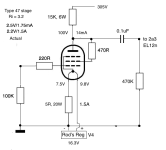
The first time I tried the 47 I thought it was inferior to the 46 as a driver tube, but for some reason it's swung the other way. Two fine valves. The 47 is really singing in my current circuit, and I use it every day to keep my 10Ys for special occasions.
4P1L does have "a certain hollow upper midrange" exactly as you describe. I never got rid of it. Needs current through it like 25mA+ but even then.
I'm curious about the P2. Never tried it but looks interesting. Can't find any posts on it, but details and curves on Frank. Anyone know it?

I realized this is a 2yr old post. Just want to say 49 is very nice sounding and its low filament current at 120ma or around allows LCL filament PSU easily, with large H used and no worry for heat.
I used 2.5H in the first L and 10H in the second, and tube rectifiers as opposed to semi-conductors. Definitely a fun project to try.
A decent choice for headphone amp too.
I used 2.5H in the first L and 10H in the second, and tube rectifiers as opposed to semi-conductors. Definitely a fun project to try.
A decent choice for headphone amp too.
- Home
- Amplifiers
- Tubes / Valves
- Preamp with #46, 47, and 49
